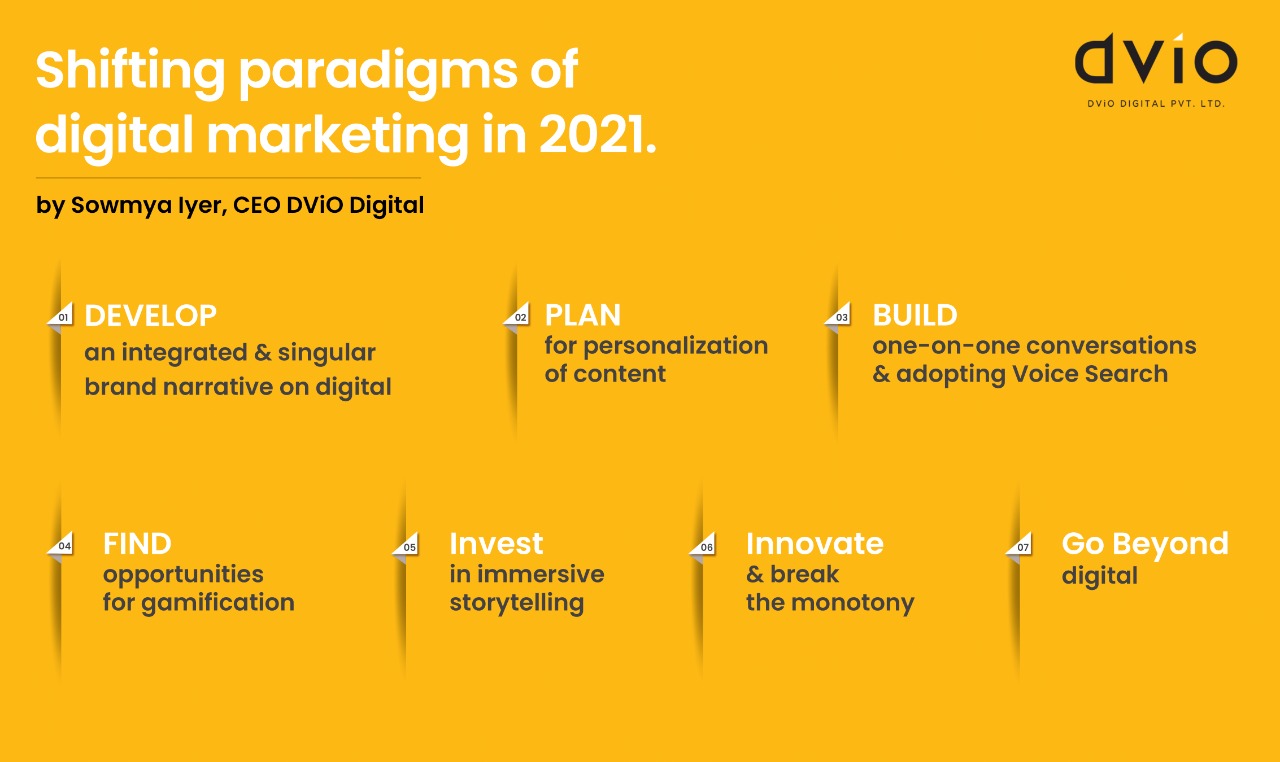
The world witnessed extraordinary acceleration of digital adoption across businesses and daily lives of people. 2020 recorded the highest engagement on digital, ecommerce, OTT, Gaming, eSports and all businesses that are digital first. While this hyper digitization is forcing businesses to realign themselves to the new normal – marketing functions within organizations have the task to step-up quickly to help put the businesses back on their growth track.
The undisputed way forward will be to scale up presence on digital channels. Skew media spends in favour of digital. While this may seem like the right thing to do– if not done right, it can drain resources with very little change in results.
The sudden surge in number of brands flocking for discovery and visibility on digital has made it mandatory to pause and reassess.
Here are the seven most significant shifts I recommend for brands to win digital marketing in 2021
1. Developing an integrated and singular brand narrative on digital:
The digital media environment is complex. Ever growing platforms, dynamic creatives formats, and advertising options coupled with the need to create content regularly for social media has left brands looking confused, with no linearity in communication and single thought holding them together.
The increased noise on digital platforms only compound this problem further.
Therefore, developing a digital brand identity is not an option anymore. While the identity should honour the fundamentals of building a brand, it should build in definitions, check points and guardrails for all platforms and content formats on digital.
Some key points to consider are –
The identity should factor in for visual discipline in the digital world of numerous and fragmented content formats.
It should also factor building a distinct conversational tone and brand persona.
While many other nuances should be factored in, it also important to keep the document agile. One cannot stop experimenting and having fun on digital.
2. Planning for personalization
Cookies will be history in 2021. While advertisers have a reason to worry, I see an interesting and perhaps a more powerful alternative—which is opt-in personalization.
Consumers will opt-in for richer and relevant experiences. And brands will need to be prepared to give them extraordinary experiences. This is can be enabled by data and technology. How to do it?
Structure your customer data meaningfully. 2. Use creativity and technology to make it worthwhile for your consumers that you have their data. The data consumers are willing to leave behind for you will be your biggest asset and also your biggest responsibility.
Examples of how we have done this at DViO:
We personalized branded videos with consumer data at scale, intercepted high potential brand conversations on social and leveraged the opportunity to amplify the brand narrative.
Our most awarded personalization initiative is how we used technology to make every fan of Game of Thrones appear on the key art poster of Game of Thrones.
These are the kind of experiences consumers will cherish forever.
 3. Building one-on-one conversations and adopting Voice Search
3. Building one-on-one conversations and adopting Voice Search
An essential part of personalization is conversations. And brands can use both, public platforms (social media) and private platforms (messengers) for conversations with consumers.
Personalized conversations create value, dialup affinity, and have the potential to build powerful brands.
And thus, the adoption of rule-based or machine learning based conversations using chatbots across websites, apps and commonly used messenger platforms like Whatsapp, Facebook Messenger, Telegram etc. will become the norm.
Voice Technology: Another high potential enabler for conversations is Voice. As per a Google report- 27 % of online audiences are already using voice in some way.
Voice is poised to change the game on Search. Thus, when you enable your brand for voice search, you are preparing the ground to build a personalized relationship and equity with your consumer.
4. Finding opportunities for gamification
“Tell me, and I will forget. Show me, and I may remember. Involve me, and you got me.” – That’s the power of gamification.
Nothing will have more impact in digital marketing than finding ways to engage and immerse your audiences– and gamification allows for exactly that.
And the fact that the growth of gaming has exceeded previous projections owing to Covid1-9– multiplies the impact of gamification.
Options available today are in-game integration, gamified digital experiences using AR, VR and chatbots, and new tech platforms on social media like SparkAR from Facebook or Lens Studio from Snapchat.
5. Investing in immersive storytelling
As 5G becomes commonplace, video will become the preferred content format for brands to build their brand. Audio Visual content is by far are the most effective form of communication today. It moves, immerses and triggers mirror neurons of empathy.
The amount of time spent on Facebook Watch, Youtube, and video first platforms like Titok stand testimony to this. But for the brands to meet the demand of the volume of videos that need to be created– democratization of video creation is the solution. AV cannot anymore remain the privilege of brands with large budgets.
While most social media apps have native video capture and DIY edit capabilities built in—the need for automation, technology and AI enabled video production will be more pronounced in 2021.
Facebook’s Oculus is also making fast advancements and will open up a whole new dimension of storytelling in VR.
6. Innovating and breaking the monotony
What’s important to remember is that 2021 will be marked by zillions of brands dialing up their digital marketing.
Brands already active on digital will step up more aggressively, those moderately present will make digital their main channel and those who ignored digital so far – will be forced adopt to stay relevant.
Thus, innovation for marketers will not be a choice, it will be a necessity. There is likely to be barrage of communication towards consumers causing information fatigue. The question creative strategists should as ask themselves is:
a. Is my content adding value in some way to my consumers—entertaining them, telling them more about what they are interested in, and surprising them in ways that will make the engagement with the brand memorable.
b. One way of doing this every day is to reimagine and play with UX and UI on platforms that you use to communicate with your consumers.
7. Going beyond digital
It’s imperative to find ways for your communication to go beyond digital and impact the consumer in their daily, physical lives.
As marketers it is our responsibility to connect people and humanize the world. It is the social and human fabric of the society that is the very base for any commerce to happen. And this need for encouraging connections is even more pronounced as we recover from the Covid19 era.
With so much digitization of the world – let’s not forget we are living in a physical world, with real people, real emotions that value touch and care.
There has never been a better time to build your brand with pillars of purpose.









